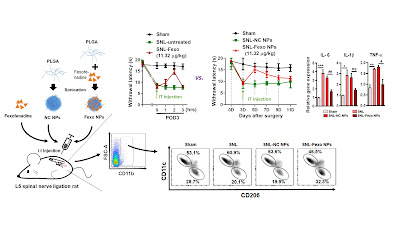GLIA-NEURON INTERACTION
Accumulation of glia, gliosis, in various neurological disorders is not a static scar,
but actively involved in pathogenesis of various neurological and psychiatric disorders.
There, glial cells produce both inflammatory and neurotrophic factors. These
factors may play a role in neuronal damage, but also play protective and reparative
roles by inducing neuroinflammation. However, definition as well as the mechanisms
of neuroinflammation is not yet clear.
In this lab. we have focused to reveal glial mechanism in various neurological disorders, especially on epilepy & neuropathic pain.
Project 2022-2023
1. Technology for Precison medicine with gene therapy combined PLGA nanoparticle
1. Gene mediators (siRNA, miRNA) or Drug repositioning targeting nanoparticle and their applications
PLGA synthesis and characterization
Drug Repositioning with PLGA nanoparticle
2. Ultrasound mediated Nanoparticle delivery to brain
Ultrasound application to stroke model
3. Optogenetic application combined with PLGA nanoparticle
4. Cell type specific CRE mouse based specific cell targeted PLGA nanoparticle
- TMEM119 Cre, GFP mice
- Cx3CR1 Cre mice
- aldh1l1 Cre mice
5. DREADDs regulated PLGA nanoparticles
2. Animal model with nanomaterial-based Technology targeting diseases
1. Neuropathic pain (Spinal nerve ligation, SNT, SNI, CPIP)
2. Infantile spasms/Epilepsy (Bet/NMDA, KA)
3. Osteoarthritis (MIA, DMM)
4. Postnatal stroke (RB)
5. Photothrombotic stroke (RB)
6. Glioma (U87GFP xenograft)
7. Depression (Social defeat stress, Early life Stress)
Project 2020-2021
1. Gene therapy combined PLGA nanoparticle-based delivery systems
1. siRNA-encapsulated nanoparticles
2. microRNA-encapsulated PLGA nanoparticles
3. Plasmid vector-encapsulated PLGA nanoparticles
4. Drug-encapsulated nanomaterial-based carriers.
5. Cell type specific CRE mouse based specific cell targeted PLGA nanoparticle
6. CRISPR/Cas9 mediated gene editing carrier-encapsulated PGLA nanoparticle
7. Optogenetic regulated PLGA nanopartcles
8. DREADDs regulated PLGA nanoparticles
2. Peptide conjugated PLGA nanoparticle development for BBB permeability
1. Astrocyte, oligodendrocyte, microglia targeted peptide-conjugated PLGA nanoparticle development
Project 2018-2019
1. PLGA nanoparticle to neuropathic pain
3. Infantile spasm
4. Osteoarthritis
5. Photothrombotic infarct
Project 2016-2017
1. Application Nanoparticles to CD200/CD200R interaction in GBM / Neuropathic pain
2. Development of exosome biomarker detection and rapid diagnostic kit of cognitive impairment in chronic traumatic encephalopathy patients and animal models
3. Primary cilia function in Neuroinflammation
Project 2015
2. ER stress and Autophagic dysfucntion in Neuropathic Pain (spinal nerve ligation (SNL) animal model)
3. Astrocyte dysfunction in Chronic Traumatic Encephalopathy (CTE) with repetitive mild traumatic brain injury (rmTBI) animal model
4. Autophagic impairment in streptozotocin (STZ)-induced Purkinje cell loss
5. Botox on TGF-beta signaling in wound healing/silicon implant
6. GABAergic interneuron differentiation in infantile spasm
Previous Projects
1. Endothelin receptor A signaling in oligodendrocyte myelination
3. PKB/Akt signaling in astrocyte activation or NFAT5 regulation AQP4 in astrocyte swelling
1. Astrocyte, oligodendrocyte, microglia targeted peptide-conjugated PLGA nanoparticle development
2. Ultrasound enforced BBB permeablility PLGA nanoparticle
3. Cold Plasma jet forced BBB permeability PLGA nanoparticle
3. Bioinformatic analysis and new drug development in glioma
4. Future application with nanomaterial-based carriers.
1. Neuropathic pain
2. Infantile spasms
3. Osteoarthritis
4. Postnatal stroke
5. Photothrombotic stroke
Project 2018-2019
1. PLGA nanoparticle to neuropathic pain
2. Hypoxia induced Astrocyte activation to glymphatics
3. Infantile spasm
4. Osteoarthritis
5. Photothrombotic infarct
Project 2016-2017
1. Application Nanoparticles to CD200/CD200R interaction in GBM / Neuropathic pain
2. Development of exosome biomarker detection and rapid diagnostic kit of cognitive impairment in chronic traumatic encephalopathy patients and animal models
3. Primary cilia function in Neuroinflammation
Project 2015
1. CD200R/Foxp3 modulation to alternative activation of microglia (M2 phenotyle) in excitotoxicity-induced neuronal death and microglia activation animal model microglia)
 |
| CD200 expression in alterative activation of microglia |
2. ER stress and Autophagic dysfucntion in Neuropathic Pain (spinal nerve ligation (SNL) animal model)
 |
| Microglia activation in spinal nerve ligation (SNL) model |
 |
| SNL model & Von Frey Test & Catwalk test |
 |
| Autophagy in GABAergic interneuron of spinal dorsal horn after SNL |
 |
| Effect of 3-methyladenine (3-MA) on mechanical allodynia by spinal nerve ligation (SNL). |
3. Astrocyte dysfunction in Chronic Traumatic Encephalopathy (CTE) with repetitive mild traumatic brain injury (rmTBI) animal model
4. Autophagic impairment in streptozotocin (STZ)-induced Purkinje cell loss
5. Botox on TGF-beta signaling in wound healing/silicon implant
 |
| phospho-SMAD2 staining in silicon implant after Botox |
6. GABAergic interneuron differentiation in infantile spasm
Previous Projects
1. Endothelin receptor A signaling in oligodendrocyte myelination
 |
| Endothelin receptor A (ETA) & MBP with treatment ETA agonist in Primary Oligodendrocyte culture |
2. Iron transport through endothelial cells and pericytes in developing brain
 |
| Nkx2.2 & TfBP in the developing chick spinal cord |
 |
| TfBP & RCA1 in endothelial cells and pericytes of developing brain capillary |
 |
| TfBP's role in Iron uptake into developing brain capillary |
3. PKB/Akt signaling in astrocyte activation or NFAT5 regulation AQP4 in astrocyte swelling
 |
| NFAT5 and AQP4 in excitotoxicity-induced cell death |
 |
| NFAT5 expression in Astrocytes |
 |
| Hyperammonia-induced astrocyte swelling |

















